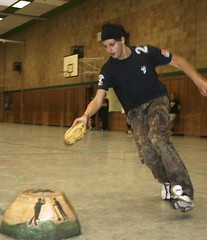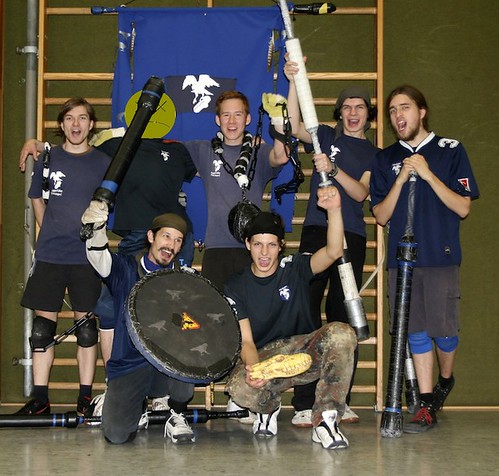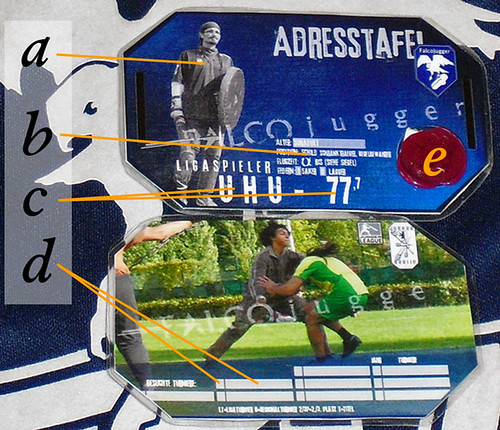27/01/11
Gezielte Hinrichtungen durch die USA und NATO-"Partnering"
Ein lesenswerter Beitrag von Christian Ströbele über den Afghanistan-Einsatz Deutschlands, der NATO und der USA in der taz, den er nicht als Rede im Bundestag halten durfte.
(Ich zitiere die taz nicht, da sie auch abmahnwütige hybrisschwangere Journalistinnen bei sich schreiben läßt; das ist das Risiko nicht wert.)
25/01/11
A100: Akteneinsicht bis 31.1.
 Neues vom 420
oder 442-Millionen Euro-Projekt 3,2km Autobahn durch Berlin (für
Autobahnen und Bänker ist das Staatsbudget unbegrenzt, wohingegen die
S-Bahn als
Unterschichten-Transportmittel dahinrostet): 14 Tage lang, bis zum
31.1., liegen nun die Akten zum Projekt "A100" zur Einsicht bereit.
Zumindest laut
Berliner Zeitung mit nur mäßigem Informationsgehalt.
Neues vom 420
oder 442-Millionen Euro-Projekt 3,2km Autobahn durch Berlin (für
Autobahnen und Bänker ist das Staatsbudget unbegrenzt, wohingegen die
S-Bahn als
Unterschichten-Transportmittel dahinrostet): 14 Tage lang, bis zum
31.1., liegen nun die Akten zum Projekt "A100" zur Einsicht bereit.
Zumindest laut
Berliner Zeitung mit nur mäßigem Informationsgehalt.
Und da Berlin schon immer groß darin war, den Mappus zu machen, darf der Verdacht geäußert werden, daß es wohl vollkommen gleichgültig ist, was die Bürger dazu sagen - der Berliner Filz hat nicht umsonst einige Berühmtheit erlangt: "Eine wirkliche Bürgerbeteiligung [...] gibt es allerdings nicht mehr. [...] Nur wer schon im bisherigen Verfahren seine Kritik geäußert hat, darf dann gegen den Beschluss klagen." - weiterlesen
Die Unterlagen für den Autobahnbau sowie der
Planfeststellungsbeschluss liegen bis einschließlich 31. Januar aus.
Senatsverwaltung für Stadtentwicklung, Am Köllnischen Park 3, Raum R116,
(Mo–Fr 9–14 Uhr).
Informationen auch im Rathaus Neukölln,
Karl-Marx-Straße 83, sowie im Rathaus Köpenick, Alt-Köpenick 21.
24/01/11
Helloween mal wieder
Die Schweden wie Amon Amarth halten ja den Geist des Metal schön engagiert hoch, wenngleich im genannten Falle mit eher monotonen Moschtechniken und um so bombastischeren Videos. Erfrischend sind und bleiben da die Jungs von damals, sofern sie sich treu geblieben sind. Beispielsweise Helloween, mit beigefügtem neuen Musikvideo zum angelegentlichen Genießen. Ihre neue CD "7 Sinners" ist ein Genuß, wohltuend echter Metal, da sind keine so beliebten billigen Konzessionen an den "Zeitgeist".
Helloween
| Myspace
Music Videos
Als Abwechslung zur Klassik ist die - allerdings gelegentlich etwas kitischig geratene - Scheibe Best Of 25th Anniversary ebenfalls zu empfehlen.
Und nun zum Kontrast los bombasticos Amon Amarth.
Aktualisierung: Copyright (vulgo: "Urheberrechts") -Absurditäten
vom Feinsten - YouTube zensiert Inhalt, weil er irgendeiner
Musikindustrie gehöre, obwohl dieser (gesperrte) Inhalt auf
der Webseite der Band selbst eingebunden wird. Ihr kriegt das Netz
noch kaputt, nur weiter so.
Nachtrag II: Auf netzpolitik.org
wird ein kleines Skript vorgestellt, mit dessen Hilfe via
IP-Identifikation (angeblich) die betreffenden Musikgesellschaften ein
schönes Banner zu sehen bekommen:

23/01/11
Falco jugger - Beizflüge 2010
Item. Beizflug 2010  2010
war ein eher ruhiges Jahr für die Falken. Zum 4. Berliner Juggerpokal
trat das Team in erfreulicher Stärke an; zudem konnte übers Jahr hinweg auf
vier weiteren Turnieren gejagt werden. Ein besonderer Höhepunkt war
das Winter-Freundschaftsturnier
in Lüneburg im Dezember, ein Spaßturnier, auf dem Falco jugger
als "Kamikaze kiää" flatterte. Trotz eher
geringer Trainingsbeteiligung waren die Turnierspiele passabel.
Teamintern war Sascha, ehemals KSJ und Teamchef von ehem. BSR, im
Frühjahr zum neuen Kapitän der Mannschaft gewählt worden, da der Uhu in
dieser Saison komplett ausgelastet war und auf die Ältestenposition des
"Schrankträgers" wanderte.
2010
war ein eher ruhiges Jahr für die Falken. Zum 4. Berliner Juggerpokal
trat das Team in erfreulicher Stärke an; zudem konnte übers Jahr hinweg auf
vier weiteren Turnieren gejagt werden. Ein besonderer Höhepunkt war
das Winter-Freundschaftsturnier
in Lüneburg im Dezember, ein Spaßturnier, auf dem Falco jugger
als "Kamikaze kiää" flatterte. Trotz eher
geringer Trainingsbeteiligung waren die Turnierspiele passabel.
Teamintern war Sascha, ehemals KSJ und Teamchef von ehem. BSR, im
Frühjahr zum neuen Kapitän der Mannschaft gewählt worden, da der Uhu in
dieser Saison komplett ausgelastet war und auf die Ältestenposition des
"Schrankträgers" wanderte.
 Besonders erfreulich ist der Schlupf eines neuen Falken, Vincent,
vor vielen Jahren einer der besten Läufer bei Exordium Berlin (und
gemeinsam mit Marc aus Irland Läufer im Dream Team der Deutschen
Meisterschaft), der auf dem vergangenen Teamtreffen als Ästling
einstimmig ins Team aufgenommen werden konnte und schon in Lüneburg
seine Qualitäten bewiesen hat. Die Saison 2011 wird sehr
vielversprechend!
Besonders erfreulich ist der Schlupf eines neuen Falken, Vincent,
vor vielen Jahren einer der besten Läufer bei Exordium Berlin (und
gemeinsam mit Marc aus Irland Läufer im Dream Team der Deutschen
Meisterschaft), der auf dem vergangenen Teamtreffen als Ästling
einstimmig ins Team aufgenommen werden konnte und schon in Lüneburg
seine Qualitäten bewiesen hat. Die Saison 2011 wird sehr
vielversprechend!
Item. Adresstafeln
Adresstafeln sind kleine Metalltäfelchen, die an einem Geschühriemen des Beizvogels befestigt werden und die Anschrift der Falknerei enthalten, sollte der Vogel verstreichen und nicht zurückfinden. Nachdem im Zusammenhang mit Jugger Liga-Mannschaften die Forderungen nach "Ausweiskontrolle" gemeldeter Stammspieler eines Ligateams aufkam, haben wir uns überlegt, anstelle des bürokratisch-schrägen Personalausweises den Anlaß für Grafikspielerei mit einer thematisch passenden Alternative zu nutzen: Eben eine "Adresstafel" für jeden Falken. Muß aber nicht zwingend am Geschüh getragen werden ...
Vorderseite:
a Spieler-Portraitbild, freigestellt oder gerahmt
b
Angaben: Alterskennung,
Position
(Anwarter usw.), Flugzeit (Im Team seit ...), Ehrenfedern
c
Spielername
und -nummer
e Siegel
Rückseite (hier eines anderen
Spielers): Farbiges Bild des Falken in Aktion.
d Besuchte
Turniere: Jahr, Kürzel
Item. Ligagremienwahl und Austragungsort Deutsche Meisterschaft
Auch über die anstehenden Wahlen wurde auf dem Teamtreffen diskutiert.
Details zu beiden finden
sich im Jugger-Blog.
Item. In ähnlicher Sache:
Der Jugger e.V. Berlin
veranstaltet am
29. & 30. Januar 2011 - Samstag 10:00 - 18:00 Uhr,
Sonntag 10:00 - 16:00 Uhr und
19. & 20. Februar 2011 - Samstag 10:00
- 18:00 Uhr, Sonntag 10:00 - 16:00 Uhr
Pompfenbauworkshops für
Interessierte, auch von Auswärts in unserer Pompfenbauwerkstatt.
Jeder,
der den Bau von Juggerpompfen nach Berliner Bauweise erlernern möchte,
ist dort gut aufgehoben und hat reichlich Gelegenheit zum Austausch (und
ggf. Genuß des Nachtlebens im Anschluß).
Mehr Informationen
dazu unter jugger.de/workshops.
Item. Neues Jugger-Weblog gestartet:
Auf JuggTales
sollen sich künftig Anekdoten zu Jugger einfinden. Eine erste gibt es
schon!
21/01/11
"Eltern im Netz": Kokain rauchende Killerspieler
Eine Perle, die dem Leser nicht vorenthalten werden soll: "Das Amok-Alphabet – Killerspieler und ihre Abkürzungen"
"A wie Amoklauf Amokläufe sind ein Phänomen der Neuzeit, das so alt ist wie ihre Ursache: die Killerspiele."
"B wie Bong [...] Gemeint ist hiermit eine Haschichzigarette, die mit Cannabis, Kokain oder Heroin gefüllt ist. Da Killerspiel-Exzesse oft sehr langwierig sind [...] wird sich so mit verschiedenen Drogen aufgeputscht."
"N wie Noob [...] Spricht ein Killer-Freak den anderen mit “Noob” an, weiß der sofort, dass er einem Killer-Kameraden gegenüber steht."
"P wie Programmiersprachen [...] Während Programme wie die Schreibsoftware Microsoft Word mit HTML programmiert wurden" -- Quelle der Zitate: elternimnetz.0day.asia/artikel/das-amok-alphabet-killerspieler-und-ihre-abkurzungen-teil-1
Das Ganze ist eine mit großem Auwand erstellte (wenngleich recht fragwürdige) Satireseite, namentlich bis zur Verwechslung ähnlich mit der Seite elternimnetz.de, deren Inhaber das Bayerische Landesjugendamt ist. Sie wirkt beim ersten Hinsehen als "echte Seite" durchaus nicht völlig abwegig: Liest man todernste Webpräsenzen wie jene von kreuznet (Zitat: "Die Stadt Köln marschiert im Stechschritt zum Homo-Endsieg"), dann ist die Lektüre eines einzelnen Beitrags von Niveau und Impetus her durchaus vergleichbar und daher nicht sofort als Satire zu erkennen. Erst beim Vergleich mehrerer Einträge offenbart sich die Sache. Das ist das eigentlich Erschütternde ...
18/01/11
Jugger im brasilianischen Fernsehen
So scheint es zumindest; eine Moderatorin des brasilianischen Senders Globosat hat sich im Volkspark Friedrichshain Berlin umgetan und mit ihrem Team einen kleinen Film dazu gemacht.
(via Juli Fox)
17/01/11
Indect: EU und der Traum totaler Überwachung
Von absoluter Hybris zeugt der Bericht auf 3sat über ein EU-Projekt
namens "Indect", das hochgradige Vernetzung verschiedener
Überwachungstechnologien und automatische Verdächtigenerkennung
verbindet. Derlei zu fördern kann nur im Interesse totalitärer Regimes,
niemals aber der Bürger liegen - böse Zungen möchten munkeln, dies sei
nur ein Symptom mehr, gut passend zur ungarischen Ratspräsidentschaft.
Quo
vadis, EU?
14/01/11
Interview with Keith, developer of the editor Scrivener
In December, I published a review on Scrivener, a fascinating new tool for novelists and screenwriters: Basically it is a text editor tailored especially to the needs of these user groups.
Now I am happy to post the complete interview with Keith, single-person developer of this brilliant piece of software, here.
 How many developers are currently in your team? Are they mainly
programmers, or are there also writers?
How many developers are currently in your team? Are they mainly
programmers, or are there also writers?
We have one
developer working on the Mac version (me) and one working on the Windows
version (which is currently in development and beta-testing - although
the Windows developer has hired someone else to help him for the
time-being). In fact, until two years ago, Literature & Latte was a
one-man company - it was just me. I didn't start out as a programmer; I
taught myself to program in order to create Scrivener. Before that I was
a teacher, and I had been struggling to write a novel for years. I was
switching between several different programs (and physical media such as
index cards) to keep track of the various strands and scenes, and I had
this idea for a program that I felt would really help me keep it all
together. The idea for Scrivener was also based on the way I approached
writing my MA dissertation - in chunks, weaving the threads together.
Eventually I bought some books on coding and it went from there. So I
was a writer - or wannabe novelist - before a programmer.
There are already lots of text editors out there. How did you get the idea to develop a new one in the first place?
It was based on my own needs. There are a lot of text editors, and even a fair few project management tools for writers, but none did exactly what I wanted. Before I created Scrivener, I kept an Excel file with coloured rows to store an outline, with a synopsis of different parts of my text on each row. From time to time, I would write out the synopses on index cards and move them around on a corkboard. Then, I would return to Excel and move the rows around there, and add any new synopses I had created. And then I had dozens of Word files lying around in the Finder, each containing a part of my manuscript, or a different idea. Switching between these was a pain. And if I wanted to update my text to match the new order of my Excel spreadsheet or index cards, I'd have to cut and paste everything into the new order. I also had dozens of research files - images, PDF files and so on - that I wanted to refer to alongside my text, and I was fed up of arranging the windows of different applications so that I could look at them next to each other. It suddenly struck me that in this age of computers, there must be a software solution for this sort of workflow. The idea seemed pretty obvious and straightforward: I just wanted a program that had a source list or tree on the left, a hierarchical arrangement of files such as you find in the Finder or Windows Explorer, and clicking on them would open the file in an editor on the right. I also wanted to be able to assign a synopsis to each document in the project, and to be able to view those synopses, and rearrange them in an outline view right within the program, so that I could edit and move around the synopses and have this rearrangement move the pieces of text with which the synopses were associated - no more painful copying and pasting just to restructure. Thirdly and finally, I wanted to have a split view that would allow me to open images and other files right alongside my text, or to view different text documents alongside one another.
So I started to hunt for software that would do this, but there was nothing. There were a few fantastic programs that came close - programs such as Ulysses and CopyWrite allowed you to navigate between different documents using a source list, for instance, other programs intended as research depositories, such as DevonThink, allowed you to store and view many different types of document. But there was nothing that combined all of these things and covered my three main criteria. So essentially, the idea came from my own messy way of working on a long text, and arose out of my own needs as a disorganised writer.
When, at which year, has that been?
I wrote down and sketched out an initial design when I was still on Windows, back around 2002, but the programming books I bought with the intention of starting the project were doorstoppers and I just couldn't get my head around programming on Windows. Then in 2004, when I moved to a Mac, I bought a couple of books on programming in Cocoa, and things clicked. By late 2005 I had an early version of Scrivener which was released as a beta on the National Novel Writing Month forums. I then spent another year completely rewriting it from the ground up, and Scrivener 1.0 eventually went on sale in January 2007.
Was Scrivener the program you had in mind, or did it sort of evolve during the development process? Any anecdotes there?
Scrivener is always evolving, but in essence it is the program I had in mind, yes. As I looked into other programs that were available in my hunt for the "perfect" software, though, some of them had an influence. For instance, although full screen mode is now rather ubiquitous, back when I was first working on Scrivener, very few writing programs had such a mode. The first program to introduce this, to my knowledge, was Ulysses, and as soon as I tried that I knew I wanted a full screen mode in Scrivener (Ulysses - which is fundamentally a very different application - also had a couple of other influences on Scrivener, such as the label and status fields). Having tested Copywrite, I knew I needed some sort of versioning feature, which was eventually named "Snapshots" in Scrivener (a name inspired by the Windows application PageFour). The look of the outliner was partly inspired by OmniOutliner. So, along the way, certain aspects of Scrivener were influenced by other software out there.
Also, originally I hadn't intended to put a corkboard into Scrivener. The idea for that came about as I was trying to think of a good way of represent the synopsis in the inspector area. It occurred to me that an index card metaphor was perfect for this, and from there I figured that having a corkboard view as an alternative to the outliner view would not only be useful but would give Scrivener a distinctive look, because no other writing software had a built-in corkboard (although of course there were several good dedicated corkboard applications around).
The first early beta of Scrivener was squarely aimed at novelists, but then I wanted to open it up for academics and so started to add footnote support and suchlike, and then I received a barrage of e-mails and requests from scriptwriters who loved the way Scrivener allowed you to break up and work on a large text project in chunks, and who wanted a scriptwriting mode. Scrivener was never, originally, intended as a scriptwriting application, but scriptwriters adopted it during the early beta stages so that by the time it was released officially in 2007, it had a full-on scriptwriting mode.
At its core, though, Scrivener is very much what I wanted right from the start - for all its features and refinements, at its core lie the three features I wanted when I set out to create it.
Why has Scrivener been a Mac program? Specific reasons for that?
Simply because I'm a Mac user, so there wasn't much point programming for a platform I didn't use! Scrivener started out as a hobby - I was just trying to create the program I wanted to use for my own writing. To begin with, I didn't even think about selling it, that only came later; I just set about coding a program for my own writing that worked on the platform I used.
What is the primary target group of Scrivener in your view?
Pretty much any writer who has to work on long texts - novelists, academics and students, scriptwriters, translators, but also lawyers and journalists. Anyone, really, who has to work on a lengthy and difficult-to-structure document.
Which features do you think make Scrivener unique compared to other text editors, and why did you choose to develop these features especially?
Although since Scrivener was released other text editors have appeared with some similar features, I think its core features are still unique, namely:
• The ability to assign a synopsis to each part of your text and move the synopses around in an outline (or corkboard) to rearrange and restructure the text, so that you can step in and out of getting an overview of the whole or working on the details.
• The ability to open different media and research documents right alongside your text within the same program.
• The ability to split up a long text into smaller chunks and then to switch between these chunks with ease, using the "binder" (list of files), or to view and edit the text as a whole using the "scrivenings" feature. (The "scrivenings" feature allows you to combine different text documents within the project so that you can edit them as though they were part of a single document - so, for instance, a novelist could break a manuscript up into individual scenes and then work on them separately, together as part a chapter, or together with the rest of the manuscript.)
What was the reason to set a focus on Fullscreen?
As mentioned above, I take no credit for coming up with a full screen mode for writing - I believe the excellent Ulysses was the first to do that, and it is now present in most writing applications, including Apple's Pages. It seemed like a great way of blocking out everything else on the computer and just focussing on what you are writing, and that's exactly what I find it useful for. In Scrivener you can still bring various tools up - you can refer to other documents using QuickReference windows, or to your notes or synopsis using a floating inspector - but fundamentally the full screen mode blocks out everything else so that you can just forge on with getting words down on the page.
There seems to be quote a lively and big community, also requests in the forum are answered with impressive speed by the development team. Do you have an insight or an impression which kind of people, or of jobs, like/use Scrivener most? How is the feedback, all in all?
The feedback has been great! It's been really gratifying, and one of the best things about working on Scrivener over the years has been the lively community that has built up around it. The majority of people who post on the forums tend to be novelists, academics and screenwriters, but there are also some translators, comic book writers, games writers, journalists, business and technical writers and other writers of non-fiction - so it's a mixed bag, really.
How would you say is Scrivener represented in Germany, compared with the US?
Well, obviously most of our users are from the US, although I should point out that of the five people on our team, only one is from the US - three of us are English and the Windows developer is Australian. At the moment the biggest barrier to us when it comes to non-English users is that Scrivener hasn't been translated into other languages yet - that's one of our top priorities for next year. We hope to be able to get Scrivener translated into some other languages next year, and German will be one of the first. All the same, I believe that our largest non-English-speaking user-base comes is in fact German.
About the future: Would you like to share your thoughts ... and maybe visions what Scrivener should become in the future?
I don't want to bloat Scrivener. We've just released version 2.0, and one of my main focuses for 2.0 was to better integrate the tools and features it has rather than to add lots of new stuff just for the sake of it. It's always tempting to add every feature users ask for, because you want to please your users, but that way madness lies. Really there aren't many more features I want to add to Scrivener - it already does everything I want, after all! The main things I do want to add are things that have been technically difficult because we're a small team and so have to rely on a lot of standard tools. So in the long run I'd love to add a fully featured styles system, or better bullets and tables (things Scrivener has but which could ultimately be better). These are things that I hope we'll be able to add or improve as we grow or get more time, but ultimately I'm really happy with Scrivener and currently my focus is on ensuring the new version is as stable and rock-solid as possible.
This interview is published under the cc nc-nd-by license. For other licensing, please contact me.
12/01/11
OpenOffice säuft mal wieder ab
Dokument eines Beitragsautors, 55 Seiten, 512 KB, konvertiert in odt, Bearbeitung mit Änderungen nachverfolgen über drei Stunden problemlos.
Dann, ohne daß etwas Tiefgreifendes geändert worden wäre: Speichern dauert über fünf Minuten, OpenOffice säuft ab, Dokumentwiederherstellung bringt es auf mindestens eine Viertelstunde.
Professionelle Textverarbeitungsprogramme sehen anders aus (und nein, Scrivener ist in diesem Falle leider das falsche Werkzeug. Denn hier werden kompatible Fußnoten, Änderungsmarkierungen und Formatvorlagen benötigt). Wer nun aber hämisch sagt, selbst schuld, kauf einfach das Produkt aus dem Hause M$, der möge sich die zahlreichen Berichte über jenes kommerzielle Programm zu Gemüte führen. Ich hatte es seinerzeit hinter mir gelassen, weil es nicht minder anfällig gewesen ist.
Aktualisierung (+1h): Es kriegt es nicht gebacken. Gut. Zeit, mit LibreOffice draufzuhalten.
Aktualisierung (+1:15h): Keine Chance. OOo hat ordentlichen Salat gemacht. Sicherheitskopie ist auch betroffen. Prima!
Aktualisierung (+1:30h): dummdidumm ...
Aktualisierung (+2:00h): Nach diversen Tänzchen zwischen Libre- und Openoffice, diversen Konvertierungs- und Reimportversuchen, Entfernung aller Änderungsmarkierungen, Tabellen und Bilder, erfolglosem Versuch des Umkopierens und geschätzten 2 nutzlosen Arbeitsstunden, läßt sich der Text wenigstens wieder bearbeiten. Jedes Speichern ist eine Zitterpartie.
Nachtrag: Oh toll. OOo Impress fügt nach Belieben chinesische Zeichen ans Absatzende einer bereits bestehenden, mit der neuesten Version nun geöffneten Präsentation. Das macht dann ja einen richtig professionellen Eindruck. Chapeau.
Nachtrag II: ... unter NeoOffice wird das Ding brav eingelesen, ohne chinesische Artefakte und reibungslos. OpenOffice, mach Dich bereit für die Tonne.

11/01/11
Zum runden Datum: Dry Martini Notfall Kit
Schönes Datum. 11.1.11.
Aus diesem Anlaß ein kleiner Bernhardiner-Notfall-Satz für den Genleman. Falls es wieder schneit.
(Wie es geht ... via Steampunk)
10/01/11
Zum Zeitgeschehen: Schwarzer Humor á la USA

(via)
Addendum: Better than cartoon, the lovely Mrs. Palin: "Palin's bizarre use of language is sure to provoke further controversy. A blood libel refers to a notorious passage in St Matthew where Jews said of the crucifixion: "Let his blood be on our heads." Later it referred to a medieval myth that Jews killed Christian children as part of a religious ritual. Giffords is Arizona's first Jewish congresswoman." -- weiter im Guardian
07/01/11
JoCognitos introduction to Jugger
A little introduction to Jugger, by JoCognito. More videos also at JuggerLiga, Youtube.
05/01/11
Saftladen Berliner S-Bahn
Addendum: Unter der von Studenten (nicht etwa der S-Bahn) eingerichteten Seite zugausfall.de können Verspätungen gemeldet und in einem Live-Ticker eingesehen werden.
Einen guten Überblick über den Umgang mit der Berliner S-Bahn durch die Deutsche Bahn, dem einstmals staatlichen (=steuergeldfinanzierten) Internationalen Logistikunternehmen, dem Fahrgäste offensichtlich als wenig aktienkursförderlich eine Last sind, findet sich in der Berliner Zeitung:
"Die Lässigkeit mit der die Bahn-Manager heute das von ihnen "abweichende Betriebssituation" genannte Fiasko noch für Jahre einplanen, ist eigentlich unfassbar. Halbwegs begreiflich wird ihre Wurstigkeit gegenüber der Stadt und den Kunden nur, wenn man sich klarmacht, dass Pünktlichkeit und Verlässlichkeit offenbar nur noch für Sekundärtugenden des öffentlichen Lebens gehalten werden. Dass ein reibungsloser Verkehr das Wesen der Stadt ausmacht und zu den elementaren Bedingungen ihrer Wirtschaft gehört, ist im Denken einer vornehmlich börsenorientierten Managerschicht vergessen worden." -- weiterlesen
Da auch Verspätungen, Mangelkalkulation und Zugausfälle ihren Preis haben, werden im Berliner Nahverkehr erst einmal die Preise saftig erhöht (zur Erinnerung: Das Ticket galt vor einigen Jahren noch zwei Stunden - auch für Hin- und Rückfahrten. Dann wurde es ein paar Cent billiger und galt dafür nur noch für eine Stecke).
Und die Verschlafenheit, mit der die für ihren Filz bekannte Berliner
Politik darauf reagiert, veranlasst beispielsweise den
Schockwellenreiter schon
seit Längerem zu der Forderung:
"[Ceterum
censeo]: Im Übrigen bin ich der Meinung, daß die Berliner
Stadtentwicklungssenatorin Ingeborg Junge-Reyer als (politisch)
Verantwortliche für das Berliner S-Bahn-Chaos zurücktreten muß."
Teeren und federn sollte man den Bahnvorstand und seine Wasserträger.



 Der Uhu führt hier ein Weblog, ist aber gewiß kein "Blogger".
Der Uhu führt hier ein Weblog, ist aber gewiß kein "Blogger".








